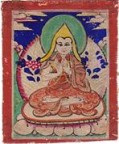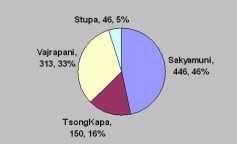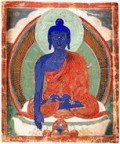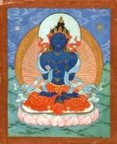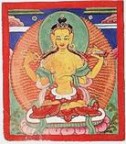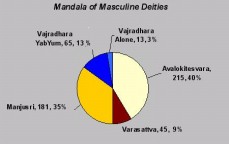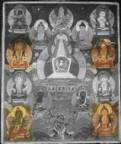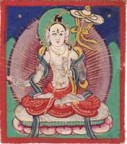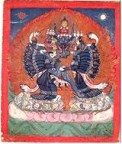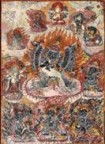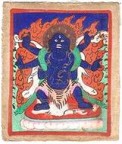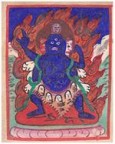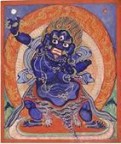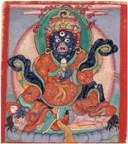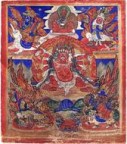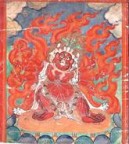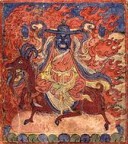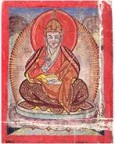The Miniature Paintings of Mongolian Buddhism:
Tsaklis, Thangkas and Burhany Zurags
by Stevan Davies
Professor of Religious Studies, Misericordia University
text and photos © asianart.com and the author except as where otherwise noted
April 08, 2010
(click on small images for large images with captions)
However, just when these trends became obvious to me, in the winter of 2006 to be precise, a new sort of thangka began to appear. These were usually extremely small, as few as three centimeters in length although most were 5 to 15 centimeters on their longest side, and some were larger. They were inexpensive, and for the most part had obviously been well used for a considerable time; some were nearly black from smoke. None of them appeared to have been made recently. Most were thangkas with single figures instead of an array. The quality of the artistic craftsmanship ranged from splendid to dreadful, indicating that their original purchasers were from a wide range of economic statuses. Most of these miniature thangkas depicted deities who would be familiar to anyone well acquainted with Vajrayana Buddhist iconography, but I had never seen an example of such miniature thangkas before. Once they began to appear, they arrived on eBay in significant numbers. All of those miniature thangkas were being sold by dealers in Mongolia. From about February 2006 to the present day Mongolian dealers have been making their inventories of miniature thangkas available to the world through eBay. As they do not have any idea of what a worldwide market might want from them, they put up for sale items ranging from museum-quality to pieces hastily dashed off. And there were lots of them; around 40 new items appeared each week on EBay. I found them very interesting and, to date, have purchased about one hundred. But I could find virtually nothing in print discussing Mongolian popular Buddhist painting, and not very much about Mongolian Buddhist art at all. Such comments as I came across presumed that Mongolian miniature Vajrayana paintings were just the local form of Tibetan Buddhist tsaklis. Apart from a handful of examples in Treasures of Tibetan Art: The Collections of the Jacques Marchais Museum of Tibetan Art most books on Vajrayana iconography have no examples of Mongolian miniatures at all. [1]
It occurred to me in April of 2007 that I had overlooked the obvious, that week after week eBay was presenting a fine selection of Mongolian miniatures and that any interested party could make a record of those items, and so I did just that for the next two and a half years. I recorded all the miniature thangkas listed on eBay, eventually over five thousand examples, setting myself only one selection rule, to exclude any that were over twenty centimeters (eight inches) in length. All the dealers whose photographed inventories I recorded and categorized were Mongolian. [2] Recently the eBay market has changed. Mongolian dealers are beginning to sell newly painted pictures, to relist pictures that they failed to sell earlier, to offer for sale a plethora of fascinating printed folk-religious apotropaic pictures and amulets (some with clear references to Vajrayana symbolism), to sell drawings of shamanistic spirits, and to reduce the number of Buddhist icons for sale. [3] It seems a good time now to end collecting and to begin analysis of what I have accumulated. I think it’s fair to say that I have recorded well over 90 percent of all Mongolian miniature thangkas offered on eBay from April 2007 to January 2010. I believe that these constitute as good a random sampling of Mongolian Buddhist painting of this type as one could hope to obtain. [4] The dealers who have been selling on eBay have tried to sell whatever inventory they could obtain in Ulaanbaatar or from agents sent into the countryside because they have no idea what products the foreign market might desire. They take what they can get from their sources and, since they have no prior contact with their potential worldwide customer base, they have no motivation to be selective on the behalf of those customers. They put what they can obtain up on eBay and hope somebody somewhere will be interested. This economic situation means that they are collecting randomly and selling a random assortment and so, accordingly, one can analyze what they have made available with confidence that selection bias has been minimal. Even if one went out to Mongolian gers or yurts in the countryside or knocked on doors in a Mongolian city and if one found hundreds of individuals willing to allow the recording of the miniature thangkas in their possession one might still find oneself with an unrepresentative collection due to regional or economic-status considerations. [5] The collection of five thousand items I have recorded from eBay is probably as random a sample as one is likely to get. But what have I collected? I have been calling them miniature thangkas but they are, insofar as they are discussed in print at all, generally called tsaklis (alternatively tsagali, tsak-li, sakhui, sakali, tsogli, etc.). While they are thangkas in the most general sense of being instances of portable Vajrayana Buddhist painting in the Tibetan tradition, they do not function as thangkas do. They cannot be rolled up, they are not to be hung on walls, they are not framed in brocade and they are quite small. Obviously they derive from the same iconographic tradition, but they are different in function than thangkas are. At first glance they might appear to be tsaklis. But they are not tsaklis. [6] Tibetan tsaklis are usually somewhat larger than the typical Mongolian miniatures, they are made of primed cloth or, most commonly, from thin sheets of paper glued together to produce a stiff cardboard. The central images are surrounded by a much wider red border than is ever found on the Mongolian paintings. Tsaklis come in sets containing considerable numbers of examples of different deities or of the same deity in various forms. Each item in such a set is recognizably similar to the others and probably was painted by the same artist. Tsakli sets can contain both icons of deities and separate representations of the principal symbols of the deity, and of offerings particularly appropriate to the deity. Tibetan tsaklis are used as portable substitute temples to allow a wide range of initiations, consecrations and offerings to be performed outside a temple building. Tsakli sets are for the use of monks in their ministrations, not for laypeople to use in the course of daily life. Accordingly, Tibetan tsaklis are thick and substantial, designed to be repeatedly physically handled, moved, placed, and held up for inspection. Because of this repeated handling, used tsaklis have well-worn rounded edges; this repeated usage and wear is the reason that Tibetan tsaklis have wide red margins surrounding and protecting the central painted image. As a further protective device, Tibetan tsaklis are often glazed to protect the painted surface.
Their use in Tibet is explained in a succinct manner in Treasures of Tibetan Art: “A set of tsak li would be commissioned by a lama or by a monastery primarily for use during initiations into the practice of a particular deity. The small painting would be placed in an offering bowl with wheat or rice in it, or else put on a torma, a special sculptural offering made of roasted barley flour and butter, the shape differing with each deity. At the same time, the lama giving the initiation invites the deity into the little painting. The lama then places the offering and the painting on top of the initiate’s head while he recites the ritual for that deity. After being used, the tsak li are put away until the next initiation is given. Tsak li can also be placed inside charm boxes.” [7] Juan Li informs us that “Tsakli paintings are employed in numerous ritual situations such as empowerment, ritual mandalas, transmission of teachings, substitutes for ceremonial items, visualization aids and funerals.” [8] Mongolian miniatures have no standardization in size whatsoever except (by definition) to be small. They are painted on cloth usually and paper occasionally but they are not made of stiff cardboard material and the cloth they are painted on may or may not be sized. They never have rounded edges from ritual use nor do they have the wide red margins of Tibetan tsaklis and they are never glazed. Tibetan tsaklis generally are rendered with extremely thin lines and do not look like small thangkas, while Mongolian miniatures are more thangka-like in their painted style.
The only tsakli-like sets of Mongolian Buddhist miniatures, i.e. related items painted by the same artist to be purchased as a collection, that I have come across are sets of eight paintings representing the eight auspicious symbols, or eight special offerings designed as ritualized substitutions for the physical offerings that they represent. This is a function akin to the function of Tibetan tsaklis. Dealers do put such sets up for sale regularly and this proves that if there were sets of deities in the manner of Tibetan tsakli deity sets, or sets of offerings appropriate to specific deities, Mongolian dealers would put them up for sale too, but this has almost never happened. Painted offerings to protector deities occur occasionally on the Mongolian market, but usually as stand-alone items rather than multi-item sets. Below there is an excellent example of this type of Mongolian offering tsakli; it is a suit of armor along with animals, gers, an offering of the eight auspicious substances, and other materials. It is probably designated for the martial protector deity Dra Lha, who appears in the data set 83 times, either alone (44) or with his eight associates (39).
Tibetan tsakli sets are frequently sold on eBay, but never by Mongolian dealers. [9] I have never seen an example of a set of Mongolian tsakli properly-so-called, but I am sure that they once did exist because, since Mongolian Vajrayana originated from Tibetan Vajrayana, and is closely related to it in theory, tsaklis of the Tibetan sort surely were sometimes used by Mongolian monks in the Tibetan manner. Since Mongolian miniatures are not thangkas except in the broadest possible sense of the word, and as they are certainly not tsaklis, we need to have another term for them. The Mongolian generic term for paintings of Vajrayana Buddhist deities is burhany zurag (alternatively, burhani zurag, borhany zuraag, etc.) which means “god painting” or “Buddha picture” or “deity picture.” Therefore I will use that terminology henceforth. In Mongolia burhany zurags were used by both Mongolian laity and Mongolian monks for devotional purposes and to attract the favorable attention of the deity represented in the painting either to bring benefits or to protect from inimical forces. They were usually placed in a frame or gau that was worn around a person’s neck or in a gau that was placed in the altar space of a ger. Often a gau functioned as a container for a set of magical amulets and printed portions of sutras and icons of deities with the favored deity depicted in a burhany zurag that was framed and facing outward. [10]
Particular deities, and hence particular burhany zurags, were assigned to individuals through astrological chance, for each person’s time of birth placed them in relationship to specific deities. Further, individuals in Mongolia who encountered particular problems in regard to finances or sexuality or health could, after consultation with astrologers and monks, purchase burhany zurags of deities whose influences were especially relevant to their problems. An individual may have accumulated quite a few burhany zurags throughout the course of his or her life as problems arose or as circumstances developed that required the assistance of different deities. Burhany zurags, then, are devotional icons symbolizing the presence and helpful assistance of deities, icons that were purchased by individuals for their particular needs. Like Roman Catholic holy-pictures of saints and of the Blessed Mother and of Jesus Christ, burhany zurags were as much or more a part of the religious life of laity as of the religious life of monks. During the period of Mongolian communism beginning in 1924, but especially the period from 1937 - 1990, Buddhist practices were outlawed, monastic life was forbidden and monks returned to lay lifestyles, monasteries were destroyed, sutras were burned and burhany zurags could not safely be displayed or produced. “In 1938, 760 monasteries were either forcibly closed or demolished. The MPR [Mongolian People’s Republic] government confiscated the monasteries’ buildings, their remaining livestock, and statues and ritual implements made of silver and gold. During this period of aggression, 6,000 monks were imprisoned, 2,000 were executed, thousands of others went into exile, more than 18,000 lower-ranking monks fled to remote areas of the countryside, and tens of thousands were forcibly secularized. By 1940, Buddhism as an institutional religion had entirely disappeared from Outer Mongolia.” [11] Buddhism was practiced in secret. This devastating fact of recent Mongolian history means that virtually all of the burhany zurags that were not made in the past few years were produced and principally used more than 70 years ago.
There are few monasteries active today in Mongolia and those few are primarily devoted to ensuring that individuals’ problems in daily life and their astrological difficulties are overcome by the efforts of monks who are paid to chant sutras appropriate to those problems. [12] Today the type of Tibetan Buddhism that some Europeans and Americans prize is being brought to Mongolia by Western Buddhist missionaries, but Mongolians are not as enthusiastic about this missionary activity as their American and European and Tibetan tutors wish they were. [13] Johan Elverskog writes that the “vast majority of Mongols today” take it for granted that “the Manchus used Buddhism in order to rule the Mongols. This sentiment is found not only among western academics and Mongol writers, but throughout the population” and “for many Mongols, Buddhism is not a religion of liberation and enlightenment, but the handmaiden of imperialism.” [14] He points out that Mongolian Buddhists are no more interested in their religion being thought to be a variety of Tibetan Buddhism than, say, Thai Buddhists are in having their religion understood to be a subcategory of Sri Lankan Buddhism. Ironically, however, while the non-Mongolian Buddhist missionaries to Mongolia encourage the use of Mongolian in chanting and liturgies, the native Mongolian samgha insists on maintaining the use of the Tibetan language in liturgy and for apotropaic chanting because it is a language over which they have a functional monopoly and, therefore, their use of Tibetan can effectively separate educated clergy from laypeople. The use of Latin and Sanscrit in Catholicism and Hinduism serves a similar purpose. Elverskog’s discussion of the conflict between native Mongolian Buddhism and the current importation of transnational Tibetan Buddhism into Mongolia concludes that while a new native Buddhism may emerge from a synthesis of the two types, at the moment Mongolian Buddhism is principally a matter of laity paying monks to perform apotropaic rituals and sutra-readings on their behalf, a matter documented in detail in Zuszsan Majer’s recent dissertation. [15] But it is surely important to remember that “even though many outside observers rarely see the local [Mongolian] Buddhist samgha in a positive light, preferring instead to highlight their undisciplined, and even lackadaisical nature, the Mongolian samgha still receives the support of the laity. It is their Buddhism.” [16] We who are interested in Vajrayana Buddhism will be wise to avoid the simple identification of Mongolian and Tibetan Buddhism and, as the cliché goes, let the Mongolians be Mongolians.
My record of photographed burhany zurags, drawn from the eBay offerings as discussed above, is a more representative census of popular Buddhist devotion to various deities prior to 1937 than of folk Buddhist practice in Mongolia today. Through analysis of the collection, which I will henceforth call the “data-set,” we should be able to determine which deities were most important in Mongolia and to what degree they were important and we should be able to do so with reasonable statistical reliability instead of doing so by anecdotal evidence, personal experience, general impression, or official Tibetan doctrine. Mongolian deities are both Vajrayana Buddhist and shamanistic, but I will have nothing to say about the latter category in this essay. Vajrayana Buddist deities are divided into two broad categories: Peaceful Buddhas and Wrathful Protectors although there are also deities of significant importance called Worldly Protectors who do not properly fit into either of those categories. I will turn my attention to those deities later on. I have copiously illustrated this essay so that the reader can enjoy and appreciate a form of religious art with which most will be unfamiliar; I have made a deliberate effort to include examples that are artistically excellent and examples that have no artistic merit at all, for both types are icons of Mongolian Buddhism and were important to the people who purchased and utilized them.
One might assume, in a manner common in western thinking, that since Mongolian Buddhism is a type of Tibetan Buddhism, and since we have a good bit of information about Tibetan Buddhism and excellent information about Tibetan iconographic theory, and the Tibetan categorization of deities, and about Tibetan use of religious images, we can confidently apply that knowledge to the Mongolian case. [17] But Mongolian Buddhism is not Tibetan Buddhism, and Mongolians are generally not pleased with the idea that their Buddhism is “really” the Buddhism of another nation entirely. Rather than assume that Mongolian categorization of deities is Tibetan and so turn to Tibetan sources for information about Mongolian religion, one might better infer Mongolian categorization from Mongolian iconography itself. I will analyze three particular small Mongolian thangkas in sequence: first a thangka of the Peaceful Buddhas, second a thangka of the Wrathful Protectors, and third a thangka of Worldly Protectors. It may be the case that Mongolian iconographic categorizations are the same as Tibetan, but I think it would be better to discover that than assume it from the outset. I will discuss the categorization of icons as they are found on the three thangkas mentioned above using the burhany zurag data-set as a census of Buddhist deities so as to discuss the percentages by which particular Buddhist deities appear and, therefore, the degree of importance that those deities have had in the practice of Mongolian Buddhism. This essay will primarily be a compilation and organization of data that may be of use to interested scholars. In addition, I will provide some discussion of how deities are iconographically categorized by Mongolian Buddhism, but I cannot possibly analyze in depth the various aspects, symbols and powers of each principal deity present in Mongolian Buddhist iconography. |
The painting pictured below is much larger than miniature burhany zurags are, although small by Tibetan standards. It is a thangka 32 centimeters by 27 centimeters, and the sets of needle holes around its periphery indicate that it once or perhaps twice was sewn into a cloth frame in the manner typical of Tibetan and Mongolian thangkas. It is a burhany zurag in a general sense, but in this essay I am using that phrase to mean deity paintings twenty centimeters or less in length. I will call larger Mongolian icons such as this one thangkas.
We do not have to rely on Tibetan texts to discover what Mongolian Buddhists thought about their deities, this thangka gives entry into a Mongolian perspective on Mongolian Buddhist deities and their relationships. It is remarkably carefully designed, as I will discuss at some length below. While it would be wrong to take this example of iconographic Mongolian thinking about deity as a normative or official account, it would also be wrong to think of it as just a casual decorative assortment of various common iconographic forms. While it is not “the” official arrangement of the Mongolian Buddhist pantheon, it is certainly “a” careful arrangement of the Mongolian Buddhist pantheon. I will show how this careful arrangement is constructed and at the same time make use of my data-set of burhany zurags to discuss with a fair amount of arithmetical precision the relative importance of the figures depicted here and the relative occurrence of sub-forms of their basic iconography. I will call the Mongolian thangka pictured below the “Peaceful Buddhas thangka.” [18] This thangka has been systematically organized into four districts, a central district with extensions to the top and the bottom of the thangka, and one inner and two outer surrounding districts each with four deities. The three surrounding districts with four deities apiece are organized so that the deities diagonally across from each other are linked conceptually more closely than the deities to which they are vertically or horizontally adjacent, although they may well have those relationships as well. The fact that the deities have a principal diagonal relationship means that conceptual lines connecting them pass through the icon of Sakyamuni Buddha who thereby constitutes a center for all three districts. Therefore, it seems reasonable to see three mandalas in the thangka, which are three units with four different but related figures surrounding a central principal deity.
The central figure in this thangka is Sakyamuni Buddha and his is by far the most common of all burhany zurags. Sakyamuni Buddha is the founder of Buddhism, who attained enlightenment by sitting in meditation under the Bodhi-tree, taught the Buddhist Dharma or doctrine, founded the sangha of Buddhist monks based on the principle of the “middle-way” and who entered nirvana when he died. In the center of the stupa is the most common depiction of Sakyamuni; he sits in the lotus position his left hand in the meditation mudra, his right hand touching the earth in a mudra symbolizing stability and, literally, grounding. In the burhany zurags, icons of Sakyamuni occur in several forms, the two most common of which are Sakyamuni alone in meditation (313 instances) or Sakyamuni in meditation with his disciples Shariputra and Maudgalyana to his lower left and right (71 instances). Also there are depictions of Sakyamuni standing (19 instances) and Sakyamuni with several other figures around him or below him (43 instances), which might be various other deities or an assemblage of Buddhas or a deity adjacent to a stupa. In the data-set there are seven burhany zurags that show Sakyamuni above a representation of Vajrapani and a stupa in a manner reminiscent of the Peaceful Buddhas Thangka.
The chart below shows the number and distribution of forms of Sakyamuni Buddha icons that appear in the data-set of burhany zurags. As discussed above, it is likely that the data-set represents a random sampling of Mongolian popular Buddhist representations that were mainly used on family altars and worn around the neck for apotropaic purposes. The chart’s term “various” describes burhany zurags where Sakyamuni Buddha is in lotus position above two figures other than his disciples Shariputra and Maudgalyana. Those figures might be Sitatapatra and Avalokitesvara, Amitabha and Manjusri, Green Tara and White Tara, Vajrapani and a Stupa, and so forth.
Sakyamni’s centrality in the Peaceful Buddhas thangka matches the principal importance he has as an icon depicted on burhany zurags where he appears 446 times, more often than any other figure. At the top of the Peaceful Buddhas thangka’s central vertical axis we find TsongKapa (1357-1419), an historical person who was the patriarch of the dominant Mongolian sect of Tibetan Buddhism, the Gelug. On burhany zurags TsongKapa is usually represented alone, sitting in yellow Gelug monastic habit in the lotus position, his hands in the dharmachakra or teaching mudra with one lotus to each side of his head. On the lotus to his left a book rests, the Prajnaparamita sutra, and a sword stands upright on the lotus to his right; the symbols of book and sword represent TsongKapa’s relationship to the Bodhisattva Manjusri who is directly to TsongKapa’s left and who is always iconographically represented with a book and a sword. On just about as many burhany zurags as depict him alone, TsongKapa’s two principal disciples Gyaltsab Je (1364-1432) and Khedrup Je (1385-1438), accompany him (65), placed just to his lower left and right. While the 63 burhany zurags of TsongKapa alone occur far fewer times in the data-set than those of Sakyamuni alone, representations of the two accompanied by their disciples occur in quite similar numbers. TsongKapa is also a principal figure on a complex type of burhany zurag found 22 times in the data set depicting TsongKapa and his two disciples emanating from Maitreya Buddha’s Tushita heaven. TsongKapa is the thangka’s mediator between earthly reality and the higher planes of Buddhahood that are otherwise represented in the picture by the deities. His position at the top of the middle column represents the human actualization of all the thangka’s energy and deity.
At the bottom of the Peaceful Buddha thangka we find an icon of Vajrapani, who has the appearance of a Wrathful Protector, but who is classified with the Peaceful Buddhas. His violent appearance stems not from passions transmuted into forces for good (as is the case with Wrathful Protectors) but from his nature as an embodiment of power, of energy directed toward enlightenment and the struggle to achieve compassion. Vajrapani is usually blue in color and stands in the “archer” posture with right leg extended and left leg bent. He holds a noose in his left hand and his eponymous vajra in his right.
In the Peaceful Buddhas thangka Vajrapani is located immediately below Sakyamuni and Vajrapani is very often portrayed in burhany zurags, 313 times. The stupa too has a significant independent role on burhany zurags; it occurs in the data-set as a stand-alone devotional icon 46 times. In the middle column of the Peaceful Buddhas thangka one might say that the whole is grounded in Mongolia itself, for Vajrapani represents Mongolia in symbolism of the Vajrayana Buddhism, with Manjusri representing China and Avalokitesvara representing Tibet. [19] In Mongolia Genghis Khan is taken to be a manifestation of Vajrapani, making that deity even more popular and frequently represented. [20] While Sakyamuni is the center of the Peaceful Buddhas thangka, Vajrapani is its foundation. Furthermore, the convention in Vajrayana art is to place the Wrathful Protectors at the bottom of a thangka if that thangka features other divinities. Here Vajrapani occupies that the place. Therefore, while Vajrapani is a Bodhisattva and not a protector, he seems here to mediate between the realm of the protectors who are, so to speak, off-camera, and the realm of the peaceful Buddhas. Vajrapani and Sakyamuni depicted alone appear in the data-set the same number of times, although in the aggregate Sakyamuni’s burhany zurags are the most numerous by far. The following is a chart of the relative instances of burhany zurag appearances of the icons appearing in the central vertical column of the Peaceful Buddha thangka giving attention to the various iconographic forms in which they most commonly appear:
If we look only at the form of Sakyamuni that appears in the thangka’s stupa, Sakyamuni alone, he is almost exactly as frequently depicted in burhany zurags as is Vajrapani. More generally, including all variant forms of the figures together and focusing on the four figures represented in the middle column we find these basic relationships in the data-set:
These relationships in the iconic tradition of burhany zurags allow one to draw conclusions about the relative significance of the different deities in the Mongolian folk Buddhist tradition. We do not need to rely on anecdotes, personal impressions or declarations by Mongolian Buddhist authorities, all of which sources may be mistaken or misinformed. We can actually measure degrees of significance, as charted above. |
Moving outside the Peaceful Buddha thangka’s middle column, there are three sets of four deities arranged as mandalas with Sakyamuni Buddha in the center of each. I am using the word “mandala” in a general sense to describe a Buddhist diagram of four different deities equidistant from a central Buddhist deity. I am not arguing technically that the mandalas of this thangka function as such in Mongolian Vajrayana philosophy. The mandalas in the thangka are made up of four icons that are, in some sense, aspects of the icon that appears in their center, Sakyamuni and they are organized quite carefully to make statements about types or sets of Mongolian buddhist deity, as will be discussed below. The first mandala is most central, as shown here:
The four deities of the mandala represented here are related on diagonal, horizontal and vertical axes. The diagonal axis is indicated by the fact that the deity at the top left, Amitayus, has a Bodhisattva crown as does the deity to the lower right, Aksobhya. Their attire, like that of all other figures in the thangka, is appropriate to the rank of Bodhisattva and indicates that they are Sambhogakaya in their essence, which means they manifest an apparitional body. On the other hand, Amitabha on the upper right and the “medicine Buddha” Bhaisajyaguru to the bottom left lack crowns and have only the curled hair and ushnisha protuberance typical of Buddha images. Their dress, like that of Sakyamuni in the center, is of Buddha rank and this indicates that they are Dharmakaya in essence, which means that they represent the formless world of ultimate truth. Amitayus and Amitabha are the same, but Amitayus is the sambhogakaya form and Amitabha is the dharmakaya form. On the horizontal axis at the top we find the conceptually related Buddhas red Amitayus (meaning Infinite Life) and red Amitabha (meaning Infinite Light) who are closely affiliated if they are not just variant powers of the same deity. Amitabha, like Aksobhya below him on the vertical axis, is a dhyani Buddha, or meditation Buddha, but no other figures in the Peaceful Buddha thangka are dhyani Buddhas. [21] The dhyani Buddha Amitabha is at the head of the lotus family of deities and is particularly charged with the virtue of compassion, he is lord of the West and of the Pure Land paradise of Sukhavati, while Aksobhya, represented below him, is lord of the East and is associated with the thunderbolt family of deities. The thunderbolt (vajra in Sanscrit, dorje in Tibetan, ochir in Mongolian) is a symbol of the active effort to achieve perfect wisdom. Blue Vajrapani, in the center of the thangka’s lowest register is affiliated with Aksobhya and especially symbolic of vajra energy. Across from blue Aksobhya we find blue Bhaisajyaguru who is the Buddha associated most closely with medicine and healing. Aksobhya and Bhaisajyaguru look almost identical, both sit in lotus position with the left hand in meditation mudra, both have the right hand extended down, but Bhaisajyaguru’s right hand opens out from the picture in the generosity mudra or gesture while Aksobhya’s right hand faces inward, the same mudra as that of Sakyamuni. Aksobhya holds a vajra in his lap, Bhaisajyaguru holds a bowl filled with medicines. The vertical axis between Amitayus above and Bhaisajyaguru below connects the two male deities who are most powerfully connected with the prevention of disease and its cure. The left side of the mandala, then, is concerned with power of healing, the right side with meditation power (through the two dhyani Buddhas). The bottom of the mandala links blue deities and they in turn are linked to the thangka’s foundational Vajrapani by color. The top of the mandala is red and links the two deities who are aspects of each other, Amitayus representing the specific powers of health and healing and Amitabha repeating the more general power of compassion, mercy and concern. These four deities are represented in the burhany zurag data-set in very different numbers. Amitayus is enormously popular as the recourse for health and long life while Amitabha, although popular, is less commonly encountered. Representations of Amitayus come in two forms: Amitayus alone, and Amitayus with two major benevolent female deities accompanying him. Amitayus is red or orange in color and sits in lotus position with two hands in meditation mudra. So far he is nearly identical to Amitabha. But Amitayus always holds a vase containing amrita the elixir of immortality as well as leaves from the ashokha tree (which is folk-etymologically relevant to his healing powers because in Sanscrit “a” is a privative meaning “not” and “shoka” means “misery”). In the most common form of his burhany zurags Ushnishavijaya, a goddess of good health with three heads (from her left to right they are blue, white and yellow) and eight arms, is seated below Amitayus and to his right, while below him and to his left we find White Tara. Because the power of this trinity is greater than that of Amitayus alone, it is by far the more common representation of power for sustaining health and one of the most valued of all burhany zurags.
Bhaisajyaguru occurs alone on burhany zurags but he is also represented as eight forms of himself, with his principal blue form in a painting’s center and seven other representations of his various powers surrounding him. In the center lowest register of the eightfold Bhaisajyaguru burhany zurag one often finds an icon of Shanglon, a protector deity associated with medical knowledge. Representations of Amitabha can portray him alone or as the central figure in detailed representations of his Pure Land paradise Sukhavati. Sukhavati evolved in east Asian Buddhism into the Pure Land, the desire to enter which after death has become a central focus of Chinese and Japanese Buddhism. In front of Amitabha one can see a pool of water containing lotus flowers from which emerge the spirits of the dead who are being welcomed into the Pure Land. Aksobhya is always portrayed alone on burhany zurags of the data-set. The relative occurrences in the data-set of the deities represented in the fourfold inner mandala of the Peaceful Buddha thangka in terms of their standard variant forms is as follows:
Amitabha and Aksobhya, the two dhyani Buddhas in this thangka, receive much more attention from Buddhist philosophers and theorists of meditation than do the deities of healing. But in the data-set Aksobhya is infrequently represented in burhany zurags, and Amitabha is only moderately popular, which is surprising when one considers his important role in Japanese and Chinese Buddhism of facilitating admission to Sukhavati, his Pure Land. Because people need divine assistance in matters of maintaining health and medical relief of illness, Bhaisajyaguru is second in the number of representations only to Amitayus. In the world of folk Mongolian Buddhism, which is the world of burhany zurags, the icons of deities of healing and of maintaining health vastly outnumber the more abstract deities of compassion and of power. |
In the Mandala of Four Masculine Deities the figures’ principal relationships are diagonal, connecting the separate icons appropriately through the central figure of Sakyamuni Buddha. The figure to the top left is the Adi Buddha Vajradhara in yabyum position, i.e. united with his female aspect Vajrayogini. Vajradhara literally means “holding the vajra,” which is a masculine symbol, the power of proper religious practice (upaya) and compassion (karuna). While he does hold a vajra in his right hand, his right arm is crossed over his left, and in his left hand he holds a bell, which is a feminine symbol for the attainment of perfect wisdom (prajna). Vajrayogini, whom he embraces within his crossed arms, holds a chopping knife and a skull bowl, also symbolically masculine and feminine, representing discrimination and insight into voidness; the symbols are related as Vajra:Bell::Knife:Bowl::Compassion:Wisdom The Adi Buddha Vajradhara is the ultimate primordial Buddha from whom Sakyamuni himself emanates. On the Peaceful Buddhas thangka he is blue and his consort is lighter blue. On burhany zurags he is always blue if he is depicted alone; when he is depicted with his consort in yabyum both he and she are almost always white.
Diagonally below Vajradhara we find Vajrasattva, who holds the vajra in his raised right hand and the bell lowered in his left hand. He does not have crossed arms and rarely is depicted with a yabyum consort. Vajrasattva is more a manifestation of energy than Vajradhara is, but both can be considered Adi Buddhas, Buddhas from whom all other Buddhas emerge.
Both Vajradhara and Vajrasattva hold the symbols of vajra and bell; Vajradhara’s companion Vajrayogini holds variations of those symbols, the chopper and skull-cup. These symbols represent, to use single words, compassion and wisdom. That duality is the principal focus of Vajrayana Buddhism, whose very name comes from the vajra. Two Bodhisattvas are the most important iconic representations of compassion and of wisdom. Manjusri, who is the Bodhisattva of Wisdom found in the Peaceful Buddha thangka at the top directly to the right of Vajradhara, and Avalokitesvara, who is the Bodhisattva of Compassion found below Vajradhara directly to the left of Vajrasattva. Together those four icons form the upper mandala of four deities. The vajra-and-bell symbolism of wisdom and compassion found in the diagonally connected icons of Vajradhara and Vajrasattva is mirrored in the diagonal connection between Manjusri and Avalokitesvara representing the symbolic incarnations of wisdom and compassion.
There are several forms of Avalokitesvara, whose name means “the deity who looks down upon the world.” The iconographic form found in the Peaceful Buddhas thangka is four armed Chaturbhuja Avalokitesvara in lotus position holding a chain of prayer beads in his right upper hand and a lasso in his upper left; his other two hands are together in the anjali mudra. The eleven headed Ekadasamuka Avalokitesvara is a form equally popular in burhany zurags and a significant number of those are poorly painted inexpensive versions showing, I think, that this icon was especially valued despite its being particularly difficult to produce. Other forms, such as lotus-holding Padmapani Avalokitsesvara, lion-riding Simhanada, and Avalokitesvara Amoghapasha who stands holding a vase and a mirror, are somewhat less common. Representations of Avalokitesvara occur in the data-set with the following distribution of forms. Such seldom-represented forms as Avalokitesvara Padmapani and Avalokitesvara Simhanada are counted in the category “various.”
Diagonal to Avalokitesvara the Bodhisattva of compassion on the Peaceful Buddhas thangka is the Bodhisattva of Wisdom, Manjusri,whose name literally means “Gentle Glory.” Unlike Avalokitesvara, Manjusri appears in one primary iconic form.
He is usually yellow or golden, but can be dark in color; he carries a sword aloft in his right hand and a lotus-stem in his left leading to a lotus flower upon which rests a book, the Prajnaparamita Sutra.
The following chart gives a breakdown of burhany zurag forms as they occur in the mandala of four masculine deities in the Peaceful Buddhas thangka. It may not be surprising that icons of the representative of compassion, Bodhisattva Avalokitesvara, outnumber those of the representative of wisdom, Bodhisattva Manjusri. The two great Adi Buddhas Vajradhara and Vajrasattva are evidently perceived to be less immediately helpful to those in need of practical help than the two Bodhisattvas are and so they are less common on burhany zurags. The Mandala of Four Feminine Deities
The fourth section of the Peaceful Buddhas thangka arranges four female deities in quadrilateral order around the Sakyamuni stupa. The symmetry of the deities is both horizontal and diagonal. At the top left and bottom right are Ushnishavijaya and White Tara who are associated deities of good health. These two goddesses are depicted together below Amitayus on the majority of his burhany zurags. Ushnishavijaya, whose name combines the word for the protrusion at the top of a Buddha’s head (ushnisha) with the word for victory (vijaya), has three heads and ten arms. Her top right hand holds an image of Buddha Amitabha or his mantra. She is known as Bizya in Mongolian as is another multiarmed goddess, this one with a blue face, a white face and a red face, who holds a dharma-wheel instead of an Amitabha image or mantra and whose hands, although also holding bow and arrow, are in somewhat different positions. Both versions of Bizya are represented in burhany zurags and both are associated with good health and long life. White Tara (see figures 5 and 6) or, in sanscrit, Sitatara, is the nearest thing Vajrayana Buddhism has to a mother goddess. Her iconography specifies that she is a beauty sixteen years old (which is, for that matter, the same age as was the Blessed Mother of Christianity when she gave birth, according to authoritative legend). White Tara is often said to be the most important female deity in Tibetan buddhism, but she is somewhat less frequently encountered in Mongolian burhany zurags than Green Tara is. White Tara has one head and two arms, but seven eyes, one in the center of her forehead, two in her face, one on each palm, one on the sole of each foot. She is seated in lotus position with a lotus flower in her left hand and her right hand in the mudra gesture of generosity.
Horizontally across from White Tara in the Peaceful Buddhas thangka we find Green Tara, whose iconography depicts her as a more serious woman than White Tara. White Tara and Green Tara are closely affiliated goddesses, as indicated by the fact that they have gold halos in common; the same artistic device unites the deities Amitayus and Amitabha above. While White Tara is the “consort” of Avalokitesvara, Green Tara represents the energy, the “shakti” of Avalokitesvara. [22] White Tara’s representations often show her gently smiling, Green Tara is usually depicted as relatively stern. Green Tara holds two lotuses that are often blue in color, and she sits in the position called Lalitasana or the charming posture. Her right hand, like White Tara’s is in the gesture of generosity. While there is only one common form of the iconographic representation of White Tara, Green Tara is depicted in other ways on burhany zurags; she is shown seated alone, or, more rarely, she is seated with two standing associates: to her left peaceful yellow Marichi and to her right wrathful blue Ekajati.
Burhany zurags are painted of Green Tara in eight forms, usually with one large central form with seven smaller forms surrounding her, which represent her power to help human beings overcome the eight fears: fear of demons, imprisonment, water, snakes, thieves, elephants lions and fire. She can also occur on icons in a collection of twenty two forms, with one central and twenty one surrounding forms, either all in green or of diverse colors. Both White and Green Tara are extremely popular in Mongolia as they are in Tibet and Nepal. The data-set charted demonstrates that in Mongolia Green Tara takes some precedence over White Tara in folk Buddhism. In the Peaceful Buddhas thangka white Tara is situated diagonally across from Ushnishavijara, her counterpart in the very popular trinity of gentle healing deities presided over by Amitayus. Diagonally across from Green Tara we find the goddess with the white parasol, a device symbolic of protection from illnesses, demons and other threats, whose name comes from her primary symbolic device; she is White-Parasol or Sitatapatra. Sitatapatra is stern and energetic and can be portrayed as semi-wrathful with a scowling, but not ferocious, countenance.
Usually she is seated alone, but she can be painted with six or eight arms with a blue, a white, and a red face, holding a white parasol and holding a banner, and there are versions of that icon lacking the white parasol and banner entirely, but otherwise holding the same objects and possessing the same faces. In this form she is quite similar in appearance to Ushnishavijaya who is horizontally across from her on the Peaceful Buddhas thangka. Goddesses of this type are called Bizya in Mongolia and are associated with long life and with the maintenance of health.
Ushnishavijaya is always depicted with multiple arms and three faces, which are in her case blue, white and yellow from her left to right. The fact that Sitapatra has many-armed three-faced forms makes her more iconographically akin to Ushnishavijaya than it might appear from simple perusal of her most common form. This chart gives the percentage of occurrence of the four principal Mongolian Buddhist goddesses as they appear in the data-set of burhany zurags. There is another fairly prominent feminine deity, one who has the specialized role of bringing babies and benefiting babies. She has red hair, holds a baby in her lap, and appears to be more “wrathful” than “peaceful” in aspect. She appears in the data-set in 44 instances. If we assume that the Peaceful Buddhas thangka categorizes Mongolian Buddhist deities in a way representative of at least one pattern of Mongolian thinking, then it is significant that the four categories of deity found in that thangka are divided among the 2,696 items in the data-set that appear in the Peaceful Buddhas thangka as follows:
Three of the categories are rather even, numerically, but the presence of both Sakyamuni and Vajrapani in the central column give that section of the thangka higher representation in the data-set. It is a shame that we cannot know who painted the Peaceful Buddhas thangka or how he developed his organizational principles but at least we can know one important thing, that however influenced by Tibetan ideology he might have been, his principles and practices were Mongolian. |
Dharmapala means protector of the teachings and, by extension, protector of the people who are affiliated with the teachings. In theory a Dharmapala is a demonic deity who has been conquered, converted and domesticated into the service of Buddhism to protect the religion and its people from all manner of harm. Dharmapalas are sometimes called “wrathful Buddhas” in contrast to the peaceful Buddhas discussed above, but they are not “Buddhas” at all and “wrathful” doesn’t describe their protective powers. Still, “wrathful Buddhas” is a well established term for them. By Mongolian convention there are ten principal Protectors or, in Mongolian, sakhius. But, while there is agreement on the names of nine of them, the burhany zurags and Mongolian thangkas evidence some disagreement over exactly who the tenth might be.
Burhany zurags, following Tibetan practice, will center a collection of the ten Dharmapalas around an image of Yamantaka, the destroyer of death, whose hugely complex image has a principal face that is that of an enraged bull and six additional faces, three to the left and three to the right of the central face. He has thirty four hands holding symbolic weapons, and sixteen legs, eight are crushing animals and gods to his left, and eight crush birds and gods to his right. He has two heads above his central head, the topmost being the head of the Bodhisattva Manjusri with a “slightly wrathful” appearance. Yamantaka is the wrathful form of Manjusri. He embraces his consort Vajravetali. He can be depicted alone in burhany zurags or surrounded by nine other Dharmapalas. In addition the seated figure of TsongKapa surmounts the whole scene, for the vision of Yamantaka in this form stems from the Gelug school of Tibetan Buddhism that TsongKapa established. The thangka illustrated below is clearly a “folk art” creation, but it has been carefully prepared and it contains the iconographic details to be found in versions painted by more professionally skilled artists. Unlike the Peaceful Buddhas thangka, which is not a standard iconographic motif, thangkas such as the one below containing nine other Dharmapalas centered on Yamantaka are not uncommon even among the burhany zurags, whose small size makes such a complex map of embodied energies a particular challenge. I will call this iconic type Dharmapala thangkas, for while they display Yamantaka prominently, they are designed to display the whole array of Dharmapalas and not just one. Almost all of the Dharmapalas are shown against a background of fire that is usually red-orange in color, although it can be dominated by black-gray smoke; Mahakala’s flames are always red-orange; Palden Lhamo’s flames are often grey-black. The Dharmapalas Thangka below is filled with energy and action, shooting flames and curling smoke, rolling clouds and dancing deities dominate the picture in every respect but one, the little figure of TsongKapa sits calmly atop the whole just as he does in the Peaceful Buddhas thangka. In both cases his presence affirms the sectarian Gelug origin of the artwork and affirms that despite the multiplicity of superhuman figures in the painting, a human being rises above all the other iconic forces.
Here, as in the Peaceful Buddhas thangka, the deities stand in a landscape of rolling grassy Mongolian hills; similar thangkas from Tibet often have snowcapped mountains as their background. Also, as in the Peaceful Buddhas thangka, half of the deities are stationed above the landscape and half within the landscape, with a central figure crossing the center line, dominating and uniting both halves of the picture. At the bottom of the Dharmapalas Thangka stands a line of three major protective deities, from our left to right, Yama, Mahakala and Palden Lhamo. As depicted they are larger in size than any other Dharmapalas except Yamantaka and this represents their greater importance. Also, within the plane of the painting, they stand nearer the viewer than any of the others. These three are so tightly associated one with the other that their trinity has a special name: gonchoi lkhaa sum. Yama has a buffalo head and stands dancing on a kneeling buffalo beneath whom is a naked man. Accompanying Yama is his twin sister and consort Yami, who is also known as Chamundi. Yama received his odd head because, the story goes, when he was a human sage meditating in a cave two bandits with a stolen bull entered the cave, slaughtered the bull and prepared to feast on it. Yama, enraged at the interruption and at having been made to witness such slaughter, spoke up and was beheaded for his temerity. But, to the thieves’ astonishment, he remained alive, replaced his own head with that of the bull, killed the thieves, ate them and then began to roam the countryside seeking whom he might devour. The terrified country folk appealed to Manjusri the great Bodhisattva, who then assumed the ferocious form of Yamantaka or ‘destroyer of Yama.’ He proceeded to successfully subdue and domesticate Yama.
These images show the remarkable amount of detail that artists of burhany zurags can bring into very small spaces. They are filled with life and energy, fire and motion just like the whole Dharmapalas thanka is. Mahakala, which means “great black one,” has several forms but the six-armed form represented in the central lower register of the Dharmapalas Thangka is by far the most common. Mahakala’s various forms are treated as though they are separate independent Dharmapalas; one of the more prominent forms of ‘the great black one’ is even white in color. His six-armed “shadbhuja” form stands on and holds the flayed skin of an elephant, holds a chopper and skull-cup in from of him and wears a crown of skulls like all Dharmapalas do. The icon to the left below appears to be of considerable age, the icon below right is more recent and presumably was less expensive when originally purchased, for it surely is reasonable to assume that the price of burhany zurags is proportional to the amount of artistic effort and excellence that they represent.
Beside Mahakala in the lowest register of the Dharmapalas Thangka we find Palden Lhamo, the only female Dharmapala, riding her horse (according to her legend it is a mule, but it is usually painted as a horse) across a sea of blood surrounded by mountains. Despite the complexity of her iconography Palden Lhamo is frequently depicted in burhany zurags partly, one suspects, because artists appreciated the challenge in portraying her detailed iconography, and it may be the case that Mongolian artists took more pleasure in drawing her horse than in drawing the deity herself.
The three deities in the lower register, the gonchoi lkhaa sum, are iconographically subordinate to the Yamantaka, the central figure of the Dharmapalas Thangka, but the number of instances of these four we find in the data-set of burhany zurags gives us a different impression of their relative significance to Mongolian Buddhist culture as one can see in the chart below:
While Yamantaka dominates the scene in the Dharmapalas Thangka and is iconographically depicted as possessing essentially infinite power beyond all beings including the gods beneath his feet, the burhany zurag data-set shows that Mahakala and, especially, Palden Lhamo are more valued by Mongolian Buddhists. The red warrior Dharmapala Begtse also outnumbers Yamantaka, as we shall see. Above the three gonchoi lkhaa sum and surrounding Yamantaka we find six additional figures for whom there is no canonical arrangement in thangkas of the ten protectors. Here we find two forms of Mahakala elevated above the gonchoi lkhaa sum: White Six-Armed (Sita Shadbhuja) Mahakala, a deity particularly affiliated with acquiring wealth, and to the right of Yamantaka, Four-Faced (Chaturmukha) Mahakala, depicted below in his most inexpensive form.
Above the two alternative forms of Mahakala in the middle register of the thangka are four deities whose placement varies in different thangka renditions, but some tendencies can be traced.. Artists almost always place Begtse, a red martial deity, adjacent to Tsangs Pa known also as “White Brahma” who is a human figure riding a white horse carrying a sword with a conch in his headdress as a unique identifying motif. In the thangka being discussed here, they flank the image of TsongKapa. Their frequent juxtaposition might lead one to think that they are relatively equal in popularity, but while Begtse is often depicted in burhany zurags Tsangs Pa almost never appears. Begtse is Mongolian in origin, a central Asian war god named for his protective armor of chain-mail. The third Dalai Lama, on a trip to Mongolia, is said to have conquered and domesticated Begtse, who is always represented trampling on a human with his left foot and a prostrate green horse with his right. He is sometimes shown with two main associates and a host of other demonic warrior-assistants. Vaisravana, also known as Kubera, is a well known god of wealth originating in the Hindu tradition. He is found throughout Asia from Sri Lanka to Korea in one form or another but, oddly enough considering his propensity to bestow riches, he is not terribly popular in Mongolia. He is depicted in a variety of ways but he usually is golden in color and seated on a lion with a banner on a pole above him and a magical mongoose that spits out jewels tucked under his left arm. Nine of the ten protectors, the Dharmapalas of Mongolian Buddhism, are an established set: Yamantaka, Yama, Palden Lhamo, Shadbhuja Mahakala, Sita Shadbhuja Mahakala, Chaturmukha Mahakala, Begtse, Tsang Pa, and Vaisravana. In thangkas and burhany zurags of the ten protectors the three gonchoi lkhaa sum are always at the bottom and Yamantaka always dominates the center while the other figures can be arranged in various ways. But there is one serious area of disagreement; the identity of the tenth protector is disputed. Many thangkas have Vajrapani in that place and published discussions of the ten protectors often assume that one of them is Vajrapani. But Vajrapani is in a different conceptual category than the protectors are; he is a symbol of the energy and expedient means necessary for enlightenment and he himself is generally categorized along with Avalokitesvavra and Manjusri as one of the trinity of supreme Bodhisattvas. Vajrapani is far above the much lower level of domesticated violent protector gods who comprise the Dharmapalas. And yet, in appearance, he seems to be a Dharmapala (except that most of the time, but not invariably, he wears the jeweled crown of a Bodhisattva instead of the skull crown of a Dharmapala). So, while Vajrapani is usually the tenth protector, his place as a subordinate in that system, always inferior in size and place not only to Yamantaka but also to the three principal deities Yama, Mahakala, and Palden Lhamo, doesn’t make good sense by the logic of Mongolian Vajrayana Buddhism. Accordingly, some sets of the ten protectors make substitutions.
Sometimes, instead of Vajrapani, one finds a depiction of Mahakala Brahmarupa, who appears like an elderly white-haired man with a long bone trumpet, and sometimes one finds Simhamukhi, the female dakini goddess with a lion’s head, and sometimes, as in the Dharmapala Thangka under discussion, the tenth Dharmapala is Shanglon, a deity associated with medical learning and medical practice who quite frequently shows up at the bottom of sets of the eight forms of the medicine Buddha Bhaisajyaguru. Because the identity of the tenth Dharmapala is disputed I will continue to follow the practice of the Dharmapalas Thangka that has been under discussion and use Shanglon as my example of the tenth. The whole set of ten protectors in the reference thangka, totalling 905 instances in the data-set, is divided among the data-set of burhany zurags as follows:
It appears from this data that the overall categorization of the Dharmapalas or protectors into a set of 10 focused on, first, Yamantaka and then, secondarily Yama, Mahakala, Palden Lhamo, and finally six others of tertiary significance does not accurately reflect the regard in which these deities are held in Mongolian Buddhist life. There appear to be five protectors of the first rank, Yamantaka, the three gonchoi lkhaa sum, and Begtse. The other five are a good bit less common in the data-set. Indeed, all of them except Vaishravana have only slight signficance in terms of their appearances on burhany zurags and so, one can but conclude, have lesser importance in the lives of Mongolian Buddhists. Part Three: The Worldly Protectors
Thus far both thangkas we have examined have TsongKapa in the top center and this designates them as thangkas in the Gelug tradition, which is the predominant tradition of Mongolian buddhism. But the Nyingma tradition is present in Mongolia too. The thangka below is Nyingma, featuring the paradigmatic founder of the tradition, PadmaSambhava, in the top center position. In size it is in the category I have labeled burhany zurag for it is only 9.5 centimeters by 8 centimeters. Nevertheless it is remarkably detailed. This thangka contains icons of four “worldly protectors” who are a lower level of helpful demonic being than the great Dharmapalas, while Begtse, in the lower left corner, is of the Dharmapala category. Worldly protectors were local gods or demons who were forcibly brought under the control of Buddhist power and whose energies are now dedicated to the benefit of Buddhists. They are less powerful than Dharmapalas but also they are less reliable and may turn against their Buddhist masters if not carefully controlled. While there are only ten Dharmapalas, there is no fixed number of worldly protectors and their iconography is more flexible than that of the Dharmapalas, making the identification of their forms a challenge. This thangka features at its top central position not TsongKapa of the Gelugs but the founder lama and deity of the Nyingma sect, PadmaSambhava. The Nyingma claim historical precedence over the Gelug but the latter, in turn, claim to be a reformed and improved version of the Nyingma. Today ten of the thirty six Buddhist temples in Ulaanbaatar are Nyingma. [23] In the Worldly Protectors thangka Hayagriva holds the central position. While he is never depicted in the assembly of the Ten Protectors, Hayagriva’s popularity in Mongolian Buddhism is very great, showing that his powers are appreciated beyond the specifically Nyingma sectarian realm. Hayagriva is particularly valued for his power to drive away demons. Nomadic peoples value him particularly because his invariable identifying mark is that one or three green horse-heads emerge from his hair. He has three faces, a white face to his left, a red central face, and he has a green face to his right. Hayagriva means “horse-necked” and his neigh supposedly drives away or destroys demonic forces and so Hayagriva is particularly appropriate for a horse herding culture such as Mongolia has been.
For the Nyingma tradition Hayagriva’s yabyum form, complete with iron Garuda-like wings, represents highest attainment and highest power. It is called his Krodha Atiguhya or "Angry Highest Secret" form and in theory is to be seen only by the highest level of initiates, although the fact that this form appears fairly frequently in burhany zurags means that it is not actually restricted from the Mongolian Buddhist public in general. Remarkably, the number of burhany zurags of red Hayagriva, in his public and his secret forms combined, is matched almost exactly by the number depicting the red warrior Dharmapala Begtse, as the following chart demonstrates:
In a data-set of this size numbers so close are functionally identical and so Begtse and Hayagriva are in a tie for the level of respect they command from Mongolian Buddhists. The figure in the top left quadrant of the Worldly Protectors thangka is a form of King Pehar. Pehar is an ill-defined worldly protector whose myth of origins is as follows: Pehar was a non-Tibetan war god who was conquered and domesticated by the great warrior-magician-sage PadmaSambhava and put in charge of the huge ancient monastic establishment at Samye, Tibet. Later Pehar was forcibly removed by the fifth Dalai Lama from Samye to be brought nearer to Lhasa and stationed at Nechung, near Drepung monastery whereupon Pehar began to possess a Nechung lama through whom he gave oracular advice to the major rulers of the Tibetan monastic and governmental establishment, especially to the Dalai Lamas. Accordingly, a lama possessed by Pehar became the official state oracle of Tibet; this practice is continued to the present day. Pehar Gyalpos (Pehar kings) appear in five forms (or, equivalently, are five brothers or have five manifestations) and those are associated with activity, mind, speech, virtue and body. Only two of those forms appear in burhany zurags in any significant numbers. [24] These are the Pehar of activity (39 instances in the data-set) who is the most complex and who most frequently appears as the major form in the center of fivefold mandala arrangements of Pehar iconography. That form is usually called, simply, Pehar. Pehar Gya Jin is the other principal form, the Pehar of mind. In the thangka under discussion Pehar Gya Jin is the blue figure riding an elephant at the top left (8 instances in the data-set). On the top right of the thangka stands Pehar actualized as the state oracle of Tibet, sometimes represented as a separate deity Dorje Dragden, the “chief minister” of King Pehar’s retinue. The theory of oracular revelation holds that a person who is possessed by a particular spirit temporarily turns into that spirit. The person is absent, for the time being, and the deity is present. That deity is depicted in the top right hand portion of this thangka. On the bottom left of the thangka stands Begtse, one of the ten protectors, and to the bottom right we have Dorje Legpa riding a lion who, his iconography stipulates, looks back towards him admiringly. Dorje Legpa, like Pehar, is a demonic deity domesticated by PadmaSambhava and his principal duty is to protect the secret “treasure teachings” of the Nyingma sect. The data-set of burhany zurags has few, if any, representations of Dorje Legpa, but his principal associate Garwa Nagpo, a deity affiliated with blacksmiths particularly, occurs 38 times, almost exactly as many times as “Activity King” Pehar does.
PadmaSambhava, who appears in the top center of the Worldly Protectors thangka, is the legendary founder of Tibetan Buddhism. He is said to have been a missionary and magician, a shaman and enlightened Buddha but if he had a real human history it is lost now in a marvelous tapestry of legend and mythology. PadmaSambhava represents the Nyingma tradition as TsongKapa represents the Gelug tradition, although both figures are respected across the sectarian boundary. Since TsongKapa is emblematic of the Gelug sect and PadmaSambhava is emblematic of the Nyingma sect it is interesting to observe the ratio in the data-set of the icons of each. There are three representations of TsongKapa (119 instances) for each one of PadmaSambhava (42 instances) and this probably, in a general way, reflects the relative significance of their sects to the Buddhists of Mongolia. [25]
This study, is only an introductory survey of the miniature Buddhist burhany zurags of Mongolia looking for a way to bring Mongolian facts into a world too often dominated by Tibetan and Euro-American-Tibetan ideologues. Perhaps a global overview would be a fitting ending, a depiction of the forms of deity that the data-set indicates have been of most value to most Buddhists in Mongolia. This may give one a way of seeing beyond official teachings and anecdotally based opinions into the situation as it is or, sadly but more accurately, the situation as it was.
Of 5,120 Mongolian burhany zurags collected randomly in the data-set, 2,749 or over 53% are represented in this chart of 11 principal Mongolian Buddhist deities. [26] With the understandable exception of the Buddha, Sakyamuni, there is not one other figure who differs from his or her nearest chart-neighbor by more than one percentage point (27 instances). This fact seems to me to indicate that the distribution of deities is caused not by ideology (where I would expect the deities to be divided into rather clear-cut categories) but by preferences driven by their perceived utility in solving personal problems and protecting against personal dangers. The burhany zurags are a whole world of delightful iconic representation. They give us insight into the values of Mongolian Buddhists independently of any other forms of Buddhism. It’s time the world outside of Mongolia came to appreciate them. Copyright © 2010 text and charts and photographs by Stevan Davies. |
Footnotes
|

























